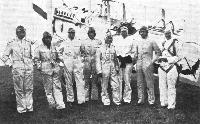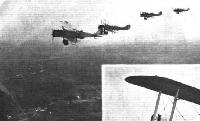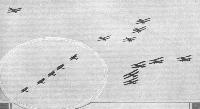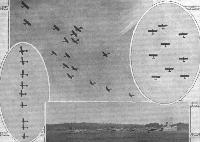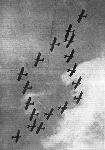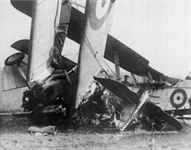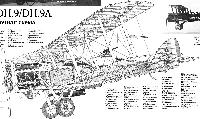
Описание
Страна : Великобритания
Год : 1918
Двухместный дневной бомбардировщик
Варианты
- De Havilland - D.H.9 - 1917 - Великобритания
- De Havilland - D.H.9A - 1918 - Великобритания
- De Havilland - D.H.16 - 1919 - Великобритания
- De Havilland - D.H.9B / D.H.9C - 1919 - Великобритания
- LWF - J-2 / Twin DH - 1919 - США
- Handley Page - H.P.17 / H.P.20 - 1920 - Великобритания
- Westland - Walrus - 1921 - Великобритания
- Поликарпов - Р-1 - 1923 - Россия
- Поликарпов - Р-2 - 1923 - Россия
- Поликарпов - МР-1 - 1925 - Россия
- De Havilland - D.H.9J - 1926 - Великобритания
Airco (de Havilland) D.H.9A
Невысокие летные данные D.H.9 могли быть улучшены путем установки более мощного и надежного мотора. Поскольку для фирмы "Rolls-Royce" создание такого мотора в короткие сроки оказалось не по силам, решили заказать большое количество двигателей Liberty 12 в США. Фирма "Airco", занятая новым самолетом D.H.10, предложила фирме "Westland Aircraft Works" в Иеовиле (Сомерсет) переделать D.H.9 под эту силовую установку. Фирма "Westland", построившая большое количество самолетов D.H.4 и D.H.9 по субподряду, поступила еще лучше, скомпоновав лучшие элементы обоих самолетов с американским двигателем. Чтобы использовать преимущества дополнительной мощности мотора, фюзеляж был усилен, а площадь крыльев увеличена. Прототип Airco (de Havilland) D.H.9A совершил с вой первый полет с двигателем Eagle VIII. Вскоре после этого в воздух поднялся прототип с двигателем Liberty. Поставки в Королевские ВВС начались в июне 1918 года.
"Westland" и субподрядчики построили примерно 885 экземпляров D.H.9A. Самолет получил звание выдающегося стратегического бомбардировщика Первой мировой войны. Производство D. Н.9А продолжалось и в послевоенные годы, когда он использовался Королевскими ВВС во время воздушных операций в Ираке и на северо-западной границе Индии. "Westland" продолжала модернизацию самолета (Nine-Ack, сокращенно Ninak) до тех пор, пока его не сняли с вооружения в 1931 году. Самолетами D.Н.9А были оснащены восемь эскадрилий дневных бомбардировщиков и шесть вспомогательных эскадрилий британских ВВС, размещенных в Соединенном Королевстве. Также они служили на почтовой авиалинии Каир - Багдад, в Египте и Палестине.
D.H.9A имел ряд модификаций, созданных в большей мере фирмой "de Havilland", чем "Airco" (отошедшей от дел после Первой мировой войны) или иностранными участниками. D.H.9AJ Stag был прототипом с улучшенным основным шасси и силовой установкой, состоящей из звездообразного двигателя Bristol Jupiter VI мощностью 465 л. с. (347 кВт). D.H.9R - гоночный самолет-полутораплан с W-образным двигателем Napier Lion II мощностью 465 л.с. (347 кВт). Обозначение Engineering Division USD-9A было дано девяти в целом схожим самолетам D.H.9A американского производства с неподвижной установкой 7,62-мм пулемета Browning, перенесенной с левого на правый борт фюзеляжа и модифицированным рулем направления. Обозначение Engineering Division USD-9B получил самолет USD-9A с двигателем Liberty 12А мощностью 420 л. с. (313 кВт).
ТАКТИКО-ТЕХНИЧЕСКИЕ ХАРАКТЕРИСТИКИ
Airco (de Havilland) D.H.9A (стандартный самолет Королевских ВВС)
Тип: двухместный дневной бомбардировщик
Силовая установка: поршневой двигатель Packard Liberty 12Vee мощностью 400 л. с. (298 кВт)
Летные характеристики: максимальная скорость 198 км/ч на уровне моря; максимальная скороподъемность 271 м в мин на уровне моря; набор высоты 1980 м за 8 мин 55 с; практический потолок 5105 м; продолжительность полета 5 ч 15 мин
Масса: пустого 1270 кг; максимальная взлетная 2107 кг
Размеры: размах крыла 14,01 м; длина 9,22 м; высота 3,45 м; площадь крыла 45,22 м2
Вооружение: один 7,7-мм синхронизированный пулемет Vickers и один или два 7,7-мм пулемета Lewis на турели Скарфа в задней кабине; 299 кг бомб
- Описание
Фотографии
-
АвиаМастер 1999-03 / В.Куликов - Славяно-британский авиакорпус на севере России /Белое дело/ (2)
Регистрационный номер: E772 DH.9a, потерпевший аварию летом 1919-го на аэродроме Березник.
-
АвиаМастер 1999-03 / В.Куликов - Славяно-британский авиакорпус на севере России /Белое дело/ (2)
Регистрационный номер: E8765 [2] Сильно изношенный DH.9a с замененными участками обшивки. Аэродром Березник, лето 1919г.
-
История Авиации 2002-02 / А.Сергиенко - Первые асы Британской Империи /Пионеры/ (2)
Регистрационный номер: E870 [2] "Де-Хэвилленд" DH-9A E870 из состава 14-й эскадрильи, на котором командующий силами RAF в Палестине и Трансиордании уинг-коммандер Рис попал в аварию в мае 1928г.
-
Air International 1974-03 / K.Isaacs - Australian air power
Регистрационный номер: F2776 Typical of the 30 gift Airco D.H.9A day bombers flown by the AAC and RAAF in 1920 and 1921, with RAF serial numbers, was Berwick-built F.2776 which later became A1-16. It operated until 9 August 1929.
-
Мировая Авиация 223
Регистрационный номер: H3510 [2] DH.9A, 8-я эскадрилья BBC Великобритании. DH.9A входит в число самых важных самолетов, применявшихся для выполнения послевоенных колониальных полицейских операций Великобритании. Изображена машина звена "B" 8-й эскадрильи, которая в начале 1920-х годов базировалась в Ханайди недалеко от Багдада. 8-я эскадрилья эксплуатировала DH.9 с 1920 по 1927 год. Под носовой частью фюзеляжа установлен дополнительный радиатор, необходимый для надежной работы мотора в жарком климате.
-
Мировая Авиация 163
Регистрационный номер: J7832 DH.9A, служившие на Среднем Востоке, покрывались аэролаком алюминиевого цвета. Изображен самолет из 45-й эскадрильи - хорошо видна эмблема "крылатый верблюд" и красного цвета киль, означавший принадлежность к звену "A".
-
Авиация и Время 2001-04 / М.Маслов, Л.Андерсон - Старый служака Р-1
D.H.9A авиаотряда "Ильич". Лето 1924г.
-
Мир Авиации 2002-01 / Л.Андерссон - Шведские авиаторы в России /Имена авиации/ (2)
De Havilland DH 9A (борт. N 5 белый) с двигателем Liberty (400 л.с.), закупленный в Великобритании.
-
Aeroplane Monthly 1983-12 / I.Frimston - Hendon's Ninack
Регистрационный номер: E9703 E9703 was a Mann Egerton-built D.H.9A; compare it with F1010 and note the different exhaust and strutless tailplane.
Final types produced by Mann Egerton were the D.H.9A (E9703 shown) and D.H.10. They were finished in battleship grey on plywood surfaces and fabric was doped dark brown to Scheme AMA -
Aeroplane Monthly 1976-06 / Personal album
Регистрационный номер: E726 De Havilland D.H.9A E726 was built by Whitehead Aircraft Ltd of Richmond, Surrey. It features a lengthy exhaust pipe extending almost to the tailplane, and is fully equipped for night flying, with lights on the top wing and flare-brackets forward of the skids on the lower wing tips.
-
Jane's All the World Aircraft 1980 / Encyclopedia of Aviation - Aircraft A-Z - v1
Airco (de Havilland) D.H.9A, 350 h.p. Rolls-Royce "Eagle."
-
Flight 1931-06 / Flight
MEMBERS OF THE DE HAVILLAND "FAMILY": A LATER TYPE, THE D.H.9A THIS HAD THE AMERICAN LIBERTY ENGINE.
-
Aeroplane Monthly 1995-08 / Personal album. Military
Регистрационный номер: F1067 Airco D.H.9A F1067 was built by Westland. The other D.H.9A to the left bears the early markings of 110 Sqn on its nose, but F1067 is not necessarily of that unit. It is unarmed, the Scarff ring has been removed and there appears to be a double opening in the top decking aft of the rear cockpit, suggesting that it might have served as a communications aircraft.
-
Aeroplane Monthly 1985-07 / P.Lamboit - Eyes in the sky (2)
Регистрационный номер: E8685 D.H.9A E8685 of 60 Sqn at Kohat in 1926. The squadron was engaged in supporting the Army and police along the North-west Frontier in India.
-
Aeroplane Monthly 1984-07 / Personal album
Регистрационный номер: H3626 Airco D.H.9A H3626 was built at Southport, Lancashire, by the Vulcan Motor & Engineering Company.
-
Flight 1940-05 / Flight
A general purpose bomber of the last war. The D.H. 9a (400 h.p. Liberty engine) remained in service for over ten years.
-
Aviation Historian 40 / V.Flintham - Dirty work (1)
Регистрационный номер: E8765 [2] A pair of RAF officers pose with D.H.9A serial E8765, allocated to RAF North Russia (Southern Area) in 1919. Note the 112lb RL (Royal Laboratories) bomb in the foreground. The first RAF use of improvised gas bombs was undertaken by D.H.9s and D.H.9As at Yemtsa, the strategically important railhead on the Vologda-Archangel line, in late August 1919.
-
Авиация и Космонавтика 2009-05 / В.Котельников - История самолета Р-1 (1)
D.H.9a "Украинский чекист" из отряда им. Ильича, Харьков, 1923г.
-
Air Pictorial 1968-11 / B.Robertson - But for the Armistice...
Регистрационный номер: E878 Standard aircraft up to the 1930s although built in the last year of the war: a D.H.9A at Karachi;
-
Aviation Historian 40 / V.Flintham - Dirty work (1)
Регистрационный номер: E8512, E8651 A line-up of D.H.9As of No 55 Sqn at Hinaidi, Iraq, in 1926. In September 1920 the unit arrived in Mesopotamia (which officially became Iraq the following year) and spent the next two decades on policing duties in the country, largely made up of operations against raiding tribesmen. Regular claims have since been made that the RAF used chemical weapons in Iraq in the 1920s, but examination of the evidence suggests it is not true.
-
Aviation Historian 1 / D.O'Connor - Flying the Furrow
Регистрационный номер: F2842 The rugged D.H.9A was one of the outstanding aircraft of its era, and differed from its predecessor, the D.H.9, in being fitted with an American-built 400 h.p. Liberty L-12 engine. This example, F2842, is seen at Hinaidi, Iraq, while serving with C Flight, 55 Sqn, in 1926.
-
Flight 1940-09 / Flight
The D.H.9A with Liberty engine.
-
Air Enthusiast 1998-03 / A.Alexandrov, G.Petrov - Aah! De Havilland-ski!
A British-built DH.9a photographed at Petrovsk in 1919, note Vickers FB.19 (Mk.I) in background at right.
Другие самолёты на фотографии: Vickers FB.19 - Великобритания - 1916
-
Aviation Historian 1 / Off the Beaten Track...
Регистрационный номер: G-CYBF [2] Lieutenant Colonel Arthur Tylee, Commanding Officer of the Canadian Air Force, stands beside D.H.9A G-CYBF during the trans-Canada flight. The epic journey between Halifax and Vancouver was completed when the aircraft reached the latter on October 17, 1920.
-
Aeroplane Monthly 1983-12 / I.Frimston - Hendon's Ninack
Регистрационный номер: F1010 [9] Restoration completed, F1010 stands in the new building at Hendon as an evocative memorial to the first gallant RAF bomber crews.
-
Aviation Historian 40 / V.Flintham - Dirty work (1)
Регистрационный номер: JR7825 A clutch of 20lb general purpose bombs on the port wing of D.H.9A JR7825, which operated with No 14 Sqn in Transjordan.
-
Aeroplane Monthly 1973-07
A line-up of "C” Flight DH9A trainers at Abu Sueir. This picture, showing the Flight’s star symbol, came from Peter Green.
-
Flight 1934-01 / Flight
POLICING THE DESERT FRONTIER: Taken at a landing ground on the edge of the Wadi Sirhan. These six machines were doing a long reconnaissance, during a Wahabi revolt. A large party of Wahabis were sitting on their frontier, but a few miles away, when this photo was taken.
-
Flight 1934-01 / Flight
A TEMPORARY CRIPPLE: A forced landing at Bair. Waiting for a new engine to be brought by lorry from Amman, 150 miles away.
-
АвиаМастер 1999-03 / В.Куликов - Славяно-британский авиакорпус на севере России /Белое дело/ (2)
Два "Де Хевилленда" и "Снайп" на аэродроме в Березнике, лето 1919г.
Другие самолёты на фотографии: Sopwith Snipe / 7F.1 - Великобритания - 1918
-
Aeroplane Monthly 1993-10 / G.Nelson - Sam Kinkead
Sopwith Snipes and Airco D.H.9As in North Russia, 1919. Kinkead led a flight of Camels as B Flight of 47 Squadron.
Другие самолёты на фотографии: Sopwith Snipe / 7F.1 - Великобритания - 1918
-
Flight 1930-08 / Flight
Регистрационный номер: J8473 The three types of machines with which this Squadron is equipped, namely, on the left: the D.H.9, of which there are four; centre the Westland "Wapiti," which number eight, and finally - sundry Avro "Lynx" biplanes.
Другие самолёты на фотографии: Avro Avro 504N - Великобритания - 1920Westland Wapiti - Великобритания - 1927
-
Flight 1927-07 / Flight
THE R.A.F. DISPLAY: Event No. 1. Air Drill by Day-bombing Squadrons. This was staged to show the improvement in performance of modern machines. 4, shows some of the D.H.9A's taking off in formation.
-
Aeroplane Monthly 1999-06 / D.Baker - A small matter of Kurdish incursions /Inter-war RAF/
The D.H.9As of 30 Sqn, plus an odd Bristol Fighter, cast lengthening shadows on Kirkuk aerodrome at 1700hr on May 28, 1924.
Другие самолёты на фотографии: Bristol F.2A/F.2B Fighter - Великобритания - 1916
-
Flight 1928-08 / Flight
THE AUXILIARY AIR FORCE IN THE AIR DEFENCE EXERCISES: Our photograph shows some of the Officers of No. 601 (County of London) Bombing Squadron, which is under the command of Squadron Leader Lord Edward Grosvenor. From right to left: Flying-Officer E. D. Whitehead Reid, Flight-Lieut. S. B. Collett, Flying Officer H. N. St. V. Norman, Flying Officer Norman H. Jones, Flying Officer J. J. Parkes, Flight-Lieut. H. N. Thornton (Adjutant), Pilot Officer A. G. Haward and Flying Officer G. J. C. Mahony (Assistant Adjutant).
-
Aeroplane Monthly 1999-06 / D.Baker - A small matter of Kurdish incursions /Inter-war RAF/
The men of A Flight, 55 Sqn, wearing full tropical kit, pose in front of one of their D.H.9As with their mascot in 1924.
-
Flight 1925-03 / Flight
Two R.A.F. D.H.9's on the Maidan, Calcutta, after their flight down from the north.
-
Flight 1928-08 / Flight
AUXILIARY AIR FORCE MACHINES AT LYMPNE: In the foreground two Avro-Lynx, and behind a number of D.H.9a's.
Другие самолёты на фотографии: Avro Avro 504N - Великобритания - 1920
-
Aeroplane Monthly 1992-07 / P.Jarrett - By day and by night /The classic inter-war RAF biplane bombers/ (2)
A D.H.9A about to be coaxed into life with the aid of a Hucks starter. Note the practice bombs, the cutout on the lower starboard wing root and the early single-axle undercarriage.
-
Flight 1927-03 / Flight
Регистрационный номер: J568 De Havilland D.H.9a ("Liberty" Engine). This is a hardy war-type that has passed through various modifications right up to the present day, and is still doing service with several of the bombing squadrons. Large quantities of this type have been produced, and it is too well known to need further reference here. The Bombing Squadrons equipped with D.H.9a's are :- Nos. 8 (Iraq); 14 (Amman and Ramleh); 24 (Communications, Kenley); 27 (Risalpur); 30 (Iraq); 39 (Spittlegate); 47 (Mid. East); 55 (Iraq); 60 (Kohat); 84 (Iraq); 207 (Eastchurch); 600 (A.A.F. Northolt); 601 (A.A.F. Northolt); 602 (A.A.F. Renfrew); 603 (A.A.F. Turnhouse); 605 (A.A.F. Castle Bromwich).
-
Aeroplane Monthly 1982-03 / Personal album
Регистрационный номер: ER8733 Plt Off Wright flying D.H.9A ER8733, another rebuilt aircraft from No 4 FTS Abu Sueir. This D.H.9A was built by the Aircraft Manufacturing Co Ltd at Hendon.
-
Мировая Авиация 163
Регистрационный номер: J7067 В годы Первой мировой войны DH.9A получил прозвище "Nineack". Самолет стал одной из основных машин британских ВВС в межвоенный период. J7067 - один из 312 самолетов DH.9A, модифицированных компаниями в 1924-1926 годах. Хорошо видна открытая кабина наблюдателя/стрелка.
-
Aviation Historian 1 / D.O'Connor - Flying the Furrow
An Airco D.H.9A of No 30 Sqn over the hostile terrain of 1920s Iraq. The unit was based in Baghdad when work on the Furrow started in the summer of 1921, and continued to operate the trusty “Ninak” until 1929, when it re-equipped with Westland Wapitis.
-
Aeroplane Monthly 1981-08 / D.Bateman - Flight from Sulaimaniya
Another D.H.9A of No 30 Sqn near Sulaimaniya.
-
Aeroplane Monthly 1981-08 / D.Bateman - Flight from Sulaimaniya
Регистрационный номер: J8147 D.H.9A J8147 of No 55 Sqn over Baghdad.
-
Flight 1928-06 / Flight
DE HAVILLAND D.H.9A: Day Bomber, with "Liberty" Engine.
-
Flight 1935-05 / Flight
"A DRESS REHEARSAL": Some D.H.9a's of No.39 Bombing Squadron carrying out evolutions over Hendon.
The D.H.9A (400 h.p. Liberty engine), which was introduced in 1918 and remained in extensive use until a few years ago, may be regarded as one of the typical intermediate types between the early and the modern military aeroplanes. -
Flight 1926-07 / Flight
"A DRESS REHEARSAL": Some D.H.9a's of No.39 Bombing Squadron carrying out evolutions over Hendon. Note the formation of Fairey "Fawns" in the left-hand corner of the top picture.
Другие самолёты на фотографии: Fairey Pintail / Fawn - Великобритания - 1920
-
Мировая Авиация 19
Регистрационный номер: E8491 Самолеты D.Н.9А, принадлежащие 39-й эскадрилье британских ВВС, в плотном боевом строю во время учебного полета, 1923 год.
-
Мировая Авиация 223
Регистрационный номер: E959 [2], H3522, J7086 55-я эскадрилья в составе авиакрыла "Месопотамия" в 1920-1922 годах выполняла миротворческие задания в Ираке. DH.9A этой эскадрильи часто выполняли рейды против баз враждебных племен.
-
Мировая Авиация 163
Регистрационный номер: E959 [2] Шахматная окраска киля - в черно-серебристую шашечку - позволяет предположить, что этот построенный компанией "Whitehead" DH.9A принадлежал звену "B" из 47-й эскадрильи, дислоцированной в Африке в 1920-1928 годах.
-
Aviation Historian 1 / D.O'Connor - Flying the Furrow
Регистрационный номер: E802 [2] 30-я эскадрилья британских ВВС летала на DH.9A в 1921-1929 годах, проведя почти все время в Ираке. Самолеты обычно несли запасное колесо на левом борту в носовой части, а на многих машинах эскадрильи законцовки крыльев и стабилизатора окрашивались в оранжевый цвет, чтобы их легко можно было обнаружить в случае вынужденной посадки.
D.H.9A E802 was one of several hundred built by the Whitehead Aircraft Co Ltd at Feltham, Middlesex, and is seen here a long way from home operating with No 30 Sqn in Iraq. Note the spare wheel lashed to the fuselage, a common - and frequently necessary - precaution adopted while flying over unpredictable and often harsh terrain. -
Aeroplane Monthly 1992-07 / P.Jarrett - By day and by night /The classic inter-war RAF biplane bombers/ (2)
Регистрационный номер: H3510 [2] D.H.9A H3510 of 8 Squadron. Ninacks were employed by this unit from late 1920 until the beginning of 1928, policing Iraq and India.
-
Aeroplane Monthly 1981-08 / D.Bateman - Flight from Sulaimaniya
Регистрационный номер: E944 D.H.9A E944 of No 30 Sqn over Hinaidi.
-
Aviation Historian 11 / M.Willis - From Farmer to Test Pilot /Duncan Menzies/ (1)
Регистрационный номер: J8189 Menzies at the controls of D.H.9A J8189 of No 45 Sqn, based at Helwan, Egypt, during his tenure with the unit from October 1928 to June 1929.
-
Aeroplane Monthly 1999-06 / D.Baker - A small matter of Kurdish incursions /Inter-war RAF/
Регистрационный номер: J7124 [2] Airco D.H.9A J7124 of 30 Sqn at 1,000ft over the Bazyan Ridge at 1100hr on August 6, 1924. Noteworthy accoutrements include a spare wheel between the undercarriage vees, screw pickets tied to the skids beneath the outboard interplane struts, an auxiliary radiator beneath the engine and an extra fuel tank just outboard of the starboard centre-section struts.
-
Aviation Historian 40 / V.Flintham - Dirty work (1)
Регистрационный номер: J7124 [2] The de Havilland D.H.9A, known affectionately as the “Ninak”, was introduced into RAF service in the last six months of the First World War and went on to become the Service’s reliable workhorse all over the world for the next decade. This example, J9124, was operated by No 30 Sqn, which flew the type in Mesopotamia/Iraq throughout the 1920s.
-
Aeroplane Monthly 1974-12 / C.Sims - Camera in cloudscape
Регистрационный номер: JR7107 [2] The author demonstrates the ideal position for air-to-air close-ups on D.H.9A JR7107 Niobe. There is reason to believe that the photograph was faked.
-
Aeroplane Monthly 1978-08 / Personal album
Регистрационный номер: JR7107 [2] A de Havilland D.H.9A of 47 Squadron, RAF, over the Nile in the 1920s. A rebuilt airframe serialled JR7107 this machine is carrying apparatus for experimental parachute research in the canister on its lower starboard wing. Flying the machine when the picture was taken was parachute specialist Fg Off C. K. Coggle.
-
Aeroplane Monthly 1987-04 / J.Meadows - The Auxiliary Tradition (1)
Регистрационный номер: J8223 600 Squadron flew D.H.9A day bombers from October 1925 until August 1929. The unit was based first at Northolt and then at Hendon.
-
Flight 1929-01 / Flight Advertisements
Actual photograph taken from accompanying 'plane, at instant after man had jumped and pulled the rip cord - his Irvin is seen instantly opening.
-
Aeroplane Monthly 1976-06 / Personal album
Регистрационный номер: E850 [2] De Havilland D.H.9A E850 Perseus was famed for its longevity of service with No 47 Squadron, based at Helwan, Egypt. It is seen here making dropping trials with "Karma-Potter" supply parachutes. Its C of A was renewed three times.
-
Flight 1922-04 / Flight
AT THE CROYDON MEETING ON EASTER MONDAY: Stocken, on the D.H.9A, 400 h.p. Liberty, winning the Club Handicap.
-
Aviation Historian 40 / V.Flintham - Dirty work (1)
A D.H.9A bounds across the valley floor taking off on another policing sortie in the Middle East. One intriguing report from a No 30 Sqn pilot in 1927 refers to a sortie in which practice runs were made with “Rains”. It remains a complete mystery as to what this refers to - perhaps a petroleum-based “sticky fire” like napalm?
-
Flight 1928-06 / Flight
THE BIRMINGHAM "SKY-TERRIERS": No. 605 County of Warwick (Bombing) Squadron, take off to bomb the "Derelict Fort" (no natives, by request!).
-
Flight 1923-11 / Flight
FORMATION FLYING AT CROYDON: On the left, two sections of No. 39 Squadron on D.H.9A's meet in formation flying, while, on the right, some of the same machines are seen coming in after their demonstration.
-
Flight 1926-07 / Flight
THE FOURTH R.A.F. "PAGEANT," 1923: A distinct advance was seen in this year's formation flying, both in quantity and quality. Ten D.H.9a's from No. 39 Squadron (Spittlegate) execute some close evolutions.
-
Flight 1926-07 / Flight
THE FIFTH R.A.F. "PAGEANT," 1924: The most thrilling event of all those presented up to this fifth year was certainly the demonstration of air drill given by two Squadrons (Nos. 39 and 207) of D.H.9a's, 18 machines in all, a slight impression of which is shown.
-
Flight 1926-07 / Flight
MORE GROUP EVOLUTIONS: These were carried out by two Wings of two day-bombing squadrons (Nos .11 and 12, Fairey Fawns, and Nos. 39 and 207, D.H. 9As). In the top view the four squadrons flying together, and below, flying towards one another.
Другие самолёты на фотографии: Fairey Pintail / Fawn - Великобритания - 1920
-
Flight 1926-07 / Flight
A FINE FORMATION: Were each of the two day-bombing squadrons, in "Squadron" formation, pass over each other and produce a wonderful pattern.
Другие самолёты на фотографии: Fairey Pintail / Fawn - Великобритания - 1920
-
Flight 1927-07 / Flight
THE R.A.F. DISPLAY: Event No. 1. Air Drill by Day-bombing Squadrons. This was staged to show the improvement in performance of modern machines. 1 shows a formation of D.H.9A's.
-
Aeroplane Monthly 1974-09 / ??? - Hendon Pageantry 1920-37
Air drill by D.H.9As.
-
Flight 1927-07 / Flight
EVENT 9, AN AIR ATTACK ON LONDON: The upper shows an "enemy" squadron of day-bombers (D.H.9's) arriving.
-
Flight 1928-08 / Flight
THE HALTON PAGEANT: Destruction of Desert Stronghold. The bombers (Bristol Fighters and a D.H.9A) bomb the fort.
Другие самолёты на фотографии: Bristol F.2A/F.2B Fighter - Великобритания - 1916
-
Авиация и Космонавтика 2021-09 / Ю.Кузьмин - Сельхозавиация СССР и России на фоне конкурентов
D.H.9A в сельхозварианте
-
Flight 1927-11 / Flight
IN THE LORD MAYOR'S SHOW: Aviation occupied quite a prominent place in'this year's procession. Our photographs show: (2) and (3) A D.H.9a day-bomber escorted by a contingent of No. 600 City of London Bombing Squadron, Auxiliary Air Force.
-
Мировая Авиация 223
Регистрационный номер: H3396 Сборка DH.9A из третьей (из семи) производственной партии на заводе "Westland" в Йовиле. Самолеты собирались "Westland" для британских ВВС по лицензии. Помимо постройки новых машин "Westland" в 1924-1926 годах выполнила ремонт нескольких самолетов британских ВВС.
-
Flight 1925-03 / Flight
HAWKER ENGINEERING COMPANY: Two views in the erecting shops. The machines in course of construction are Snipe and D.H.9A's.
Другие самолёты на фотографии: Sopwith Snipe / 7F.1 - Великобритания - 1918
-
Aeroplane Monthly 1999-06 / D.Baker - A small matter of Kurdish incursions /Inter-war RAF/
The workshops at the Hinaidi depot in 1926, with a Vernon, D.H.9As and Bristol Fighters undergoing rebuild.
Другие самолёты на фотографии: Bristol F.2A/F.2B Fighter - Великобритания - 1916Vickers Vernon - Великобритания - 1921
-
Aeroplane Monthly 1978-05 / A.Jackson - Crawford Monoplane /British pre-war ultralights/
The view shows the Avro-like tail unit, parallel strutting, Flt Lt Crawford, and three D.H.9As on major overhaul in the hangar.
Другие самолёты на фотографии: Crawford monoplane - Великобритания - 1925
-
Aeroplane Monthly 1993-02 / O.Thetford - By day and by night /The classic inter-war RAF biplane bombers/ (9)
Fawn J7206 served with Nos 100 and 503 Sqns. The type was intended to replace the D.H.9A, an example of which is visible in the background.
Другие самолёты на фотографии: Fairey Pintail / Fawn - Великобритания - 1920
-
Flight 1919-12 / Flight
Регистрационный номер: G-EAHT A Record Breaker: As announced in "Flight" last week, a Napiere engined Airco (DeH.) 9R, piloted by Capt. Gathergood, established a number of British records for speed on November 15, 1919. Our photograph shows the machine used for the flights. Capt. Gathergood, the pilot, is standing in front of the machine
-
Flight 1922-12 / Flight
A D.H.9b, with Rolls-Royce "Eagle" engine, remodelled by the Aircraft Disposal Company.
-
Aeroplane Monthly 1982-06 / Skywriters
Spanish D.H.9A, with locally modified Napier Lion and attendant plumming, bombed up and ready to go at Melilla.
-
Aeroplane Monthly 1982-04 / Personal album
Регистрационный номер: G-EBGX [2] The Lion-engined D.H.9A G-EBGX, named Aurora, modified by John Kenworthy for competing in the 1923 King's Cup Race. The aircraft was eventually sold overseas.
-
Aeroplane Monthly 1982-04 / Personal album
Регистрационный номер: G-EBGX [2] The Lion-engined D.H.9A G-EBGX, named Aurora, modified by John Kenworthy for competing in the 1923 King's Cup Race. The aircraft was eventually sold overseas.
-
Flight 1922-09 / Flight
THE RACE FOR THE KING'S CUP: Ten of the faster machines, arranged in the order of starting: 7, D.H.9A;
-
Flight 1923-07 / Flight
SOME DERBY MACHINES: A.D.C. D.H.9a (450 h.p. Napier "Lion").
-
Flight 1923-02 / Flight
An A.D.C. Modification: This D.H.9 has been altered considerably by the Aircraft Disposal Company, and among other changes will be observed the substitution of Lamblin radiators for the usual nose radiators.
-
Aeroplane Monthly 1982-04 / Personal album
Регистрационный номер: G-EBAN G-EBAN was also fitted with the 350 h.p. Eagle VIII and, with full armament, was ferried to the Spanish Air Force by the Aircraft Disposal Company.
-
История Авиации 23 / С.Корж - Коммерческая авиация /Ретроспектива/ (9)
Алан Кобхэм на крещении D.H.9 "Айлин", на котором он в 1923г. принял участие во второй гонке "Кингс Кап", но не преуспел. Любопытно, что в первой гонке 1922г. победа была одержана на D.H.4A, показавшем весьма высокую для того времени среднюю скорость 198 км/ч.
-
Flight 1924-08 / Flight
THE KING'S CUP: Mr. A. J. Cobham being congratulated on having secured second place. Inset, the Napier "Lion"-engined D.H.9 passing over the winning line.
-
Flight 1923-07 / Flight
Регистрационный номер: G-EBCG [4] D.H.9a (350 h.p. Rolls-Royce "Eagle VIII").
-
Flight 1922-09 / Flight
Регистрационный номер: G-EBCG [4] SOME OF THE STARTS FOR THE KING'S CUP RACE: Perry gets off on the D.H.9A;
-
Flight 1923-08 / Flight
Регистрационный номер: G-EBCG [4] Mr. H. H. Perry, who on the D.H.9a (350 h.p. R.R.) secured third place in the Aerial Derby Handicap, getting away.
-
Aeroplane Monthly 1982-04 / Personal album
Регистрационный номер: G-EBCG [4] D.H.9A G-EBCG was fitted with a 350 h.p. Rolls-Royce Eagle VIII for competing in the Croydon Whitsun Races in 1922. The standard nose radiator was later removed in favour of small side radiators, in which form the D.H.9A competed in the 1922 King’s Cup Race.
-
Aeroplane Monthly 1982-04 / Personal album
Регистрационный номер: G-EAXC G-EAXC was a brand new D.H.9A converted by the Aircraft Disposal Co., in 1922 and competed in the Coupe Lamblin race of that year.
-
Aeroplane Monthly 1982-04 / Personal album
Photograph showing the armament of the D.H.9As flown for demonstration to the Spanish Air Force. Note the Lamblin radiators between the undercarriage legs for cooling the 350 h.p. Eagle VIII engine. After trials in Spain a batch of D.H.9As was ordered by the Spanish Air Force.
-
Flight 1923-02 / Flight
Two Views of the Lamblin Radiators on the A.D.C. D.H. 9.
-
Flight 1928-08 / Flight
Some A.A.F. "Nurses": Attending the Liberty engine of a D.H.9a. The regular participation by A.A.F. units and the absence of forced landings prove the efficiency of the "amateur" engineers.
-
Aeroplane Monthly 1982-03 / Personal album
Plt Off Sarsfield Sampson is seen in the cockpit of another D.H.9A at Abu Sueir.
-
Aeroplane Monthly 1983-11 / L.Coombs - Cockpits of the RAF (2)
The D.H.9A was fitted with protective leather-covered pads on the ends of the Vickers gun breeches. The compass is the widely-used Type 5/17.
-
Aeroplane Monthly 1982-04 / Personal album
Photograph showing the cockpit of the D.H.9As flown for demonstration to the Spanish Air Force.
-
Aeroplane Monthly 1983-11 / L.Coombs - Cockpits of the RAF (2)
Регистрационный номер: F1010 [9] The cockpit of the immaculately-restored De Havilland D.H.9A F1010 in the RAF Museum's Bomber Command Annexe at Hendon.
-
Aeroplane Monthly 1983-12 / I.Frimston - Hendon's Ninack
Регистрационный номер: F1010 [9] The instrument panel.
-
Aeroplane Monthly 1992-07 / P.Jarrett - By day and by night /The classic inter-war RAF biplane bombers/ (2)
A good view of a D.H.9A cockpit, showing a clutter of instruments and assorted plumbing.
-
Aeroplane Monthly 1983-02 / W.Clarke - Drawing s bead (1)
The first purpose-made Reflector gun sight was produced by the optical firm of Optiche Anstall Oigee of Berlin working to Sir Howard Grubb’s patent. Illustrated here is an Oigee sight mounted on an American D.H.9 at McCook Field in 1923.
-
Air Pictorial 1977-09
Left W/Cdr. Arthur, Officer Commanding No. 431 M.U. (centre right), with the team that brought D.H.9A F1010 home from Poland. The aircraft is to be preserved by the R.A.F. Museum, Hendon
-
Aeroplane Monthly 1980-02 / News Spotlight
The RAF Museum's de Havilland D.H.9A fuselage, obtained from Krakow, Poland, in exchange for a Spitfire XVI, is having a set of spruce wings and a tailplane built in the Museum's Cardington workshops.
-
Aeroplane Monthly 1982-05 / P.Capon - Stag Lane /Capon's Corner/
An early view of the Stag Lane works with D.H.9s being reconditioned.
-
Aeroplane Monthly 1983-12 / I.Frimston - Hendon's Ninack
Регистрационный номер: F1010 [9] The view at top shows the uncovered fuselage during restoration. The badly decayed original side panel can be seen propped up on the floor. At bottom, the addition of the covered fin and rudder makes the structure look more like a Ninack.
-
Aeroplane Monthly 1983-12 / I.Frimston - Hendon's Ninack
Регистрационный номер: F1010 [9] The Scarff ring gun mounting and aft decking structure can be seen left; before the decking was added the forward and aft fuselage sections had to be mated, right.
-
Aeroplane Monthly 1983-12 / I.Frimston - Hendon's Ninack
Регистрационный номер: F1010 [9] The accuracy of F1010’s new wings was checked by rigging them to the untouched fuselage.
-
Aeroplane Monthly 1983-12 / I.Frimston - Hendon's Ninack
Регистрационный номер: F1010 [9] The view shows the main petrol tank and cabane structure. Note the “Westland Aircraft Works” transfer on the starboard aft strut.
-
Aeroplane Monthly 1983-12 / I.Frimston - Hendon's Ninack
Регистрационный номер: F1010 [9] The detail view shows the nonstandard tailplane bracing strut.
-
Aeroplane Monthly 1983-12 / I.Frimston - Hendon's Ninack
Регистрационный номер: F1010 [9] The fuselage nears completion.
-
Aeroplane Monthly 1983-12 / I.Frimston - Hendon's Ninack
The 400 h.p. 12-cylinder Liberty engine was obtained from the USA.
-
Aeroplane Monthly 1990-02 / Personal album. Military
Регистрационный номер: J8187 A D.H.9A of No 4FTS, Aboukir, Egypt, snapped after a mishap in 1930. J8187 was built by George Parnall & Company Ltd as part of a 1926 RAF contract.
-
Aeroplane Monthly 1976-06 / Personal album
Регистрационный номер: E850 [2] The long-serving D.H.9A E850 Perseus of 47 Squadron, Helwan, Egypt, after an unhappy but not-too-disastrous landing in 1926. This venerable aeroplane was "aerobatted" on its final flight.
-
История Авиации 2002-02 / А.Сергиенко - Первые асы Британской Империи /Пионеры/ (2)
Регистрационный номер: E870 [2] Авария уинг-коммандера Риса на "Де-Хэвилленде" DH-9A E870 из состава 14-й эскадрильи RAF, май 1928г.
-
Aeroplane Monthly 1986-08 / Personal album
Регистрационный номер: E890 D.H.9A E890 on its back at Abu Sueir, Egypt. The aircraft was serving with 4 FTS at the time of its crash.
-
Aeroplane Monthly 1982-03 / Personal album
Регистрационный номер: J8174 It was in this D.H.9A, J8174, that Plt Off Sarsfield Sampson wiped off the undercarriage during a crosswind landing at Abu Sueir on April 25, 1928.
-
АвиаМастер 1999-03 / В.Куликов - Славяно-британский авиакорпус на севере России /Белое дело/ (2)
Большинство потерь Славяно-Британский авиакорпус нес в результате аварий: неудачная посадка DH.9a.
-
Aeroplane Monthly 1974-03 / J.Corlett - Write-off and laugh-off
“- perched precariously on the very corner of a hangar roof” - an unconventional landing by Sir Hugh Trenchard's ADC.
-
Aeroplane Monthly 1974-03 / J.Corlett - Write-off and laugh-off
The less fortunate of the two Ninacks in the accident
-
Aeroplane Monthly 1974-03 / J.Corlett - Write-off and laugh-off
"- taxying out for a test flight -”, the second party in the head-on Ninack collision.
-
Aeroplane Monthly 1974-08 / Personal album
How to write-off a Woodcock. The radial-engined remains belong to Hawker Woodcock II J7973, and the second party is a de Havilland D.H.9A. Fg Off Shipwright was injured in this accident. Only Nos 3 and 17 Squadrons had Woodcocks, and the type was in service as a night interceptor fighter from 1925 until 1928.
Другие самолёты на фотографии: Hawker Woodcock - Великобритания - 1923
-
Aviation Historian 1 / Off the Beaten Track...
Регистрационный номер: G-CYBF [2] A photograph taken on May 14, 1980, depicting an actual-size mural of the first aircraft to land at Revelstoke, British Columbia, on October 13, 1920. Who painted it and is it still there?
-
Aeroplane Monthly 1992-07 / P.Jarrett - By day and by night /The classic inter-war RAF biplane bombers/ (2)
Регистрационный номер: E802 [2] KEITH WOODCOCK'S colour painting depicts a D.H.9A being salvaged after a mishap - a common occurrence at most training schools in Egypt and elsewhere.
-
Aeroplane Monthly 1976-07 / Personal album
Регистрационный номер: J8144 De Havilland D.H.9A No 39 Squadron
-
Мировая Авиация 223
DH.9A
-
Aeroplane Monthly 1992-07 / P.Jarrett - By day and by night /The classic inter-war RAF biplane bombers/ (2)
Airco D.H.9A (400 h.p. Liberty)
Тип фотографий
- Все фото (133)
- Боковые проекции (8)
- Ч/б фото (92)
- Кабина (7)
- Реставрация (10)
- Обломки (10)
- Рисунки, схемы, чертежи (6)


































